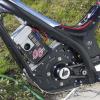-
Posts
625 -
Joined
-
Last visited
Contact Methods
-
Website URL
https://www.ossa-efi.com
Contact Information
-
I'm not exactly sure when it was (mid 1980s maybe) that street bikes began to lose the kicker. Old-timers lamented the loss. Nowadays, no street bike has a kick-starter — and for logical reasons. Bump starting became a possible (and sometimes necessary) workaround. But it's very difficult to bump-start a trials bike — although I have done it. Personally, I would keep a spare battery or lithium-ion jump-starting pack with the tow vehicle.
-
Perhaps it has something to do with it being your first post here? Perhaps it has something to do with Kenda being sold on the website (albeit with a spelling error) you promoted above?
-
Assuming there is not an electrical problem, making the starter jet richer can help. Does it have a Dellorto? If so, they have replaceable starter jets. When I did not want to wait for jets to arrive for my old TXT321, I just enlarged its original #60 starter jet hole from 0.023 inch to 0.028 inch (making it approximately a #70). Much easier to start! Figured I had nothing to lose, as I could just solder up the hole and re-drill to original size if it made things worse. The jet number is the approximate diameter in millimeters, so a #60 would be about 0.60 mm in diameter. When I drill a jet, I obliterate its original markings so the next guy is forced to measure. But I also always supply a full set of note with any bike I sell.
-
I did not know anything about the Ibex, but it's a great name for an off-road tire. A quick search revealed the Ibex endurocross tire. I would not ride that in a trial! How could faussy be so wrong? Turns out, there is a trials-specific Ibex, the K7104F and K7105. https://powersports.kendatire.com/en-eu/find-a-tire/motorcyclescooter/mxoff-road/ibex-trials/ Yup, that looks like a trials tire. But the durometer of the rubber would still be a big consideration for me. See: https://www.electricmotiontech.com/home/trials-tires
-
That's a good question. It seems to be a mix of parts. As I've said before, only half joking, no two EFI OSSAs were built identically. What is the 10th character of the VIN?
-
Sorry, no specify knowledge. But in general, if you raise the rear, the bike will turn sharper and be more reluctant to wheelie. I took a look at the Rock Shocks website. Seems like an excellent choice. I like the fact you can buy rebuild parts.
-
Glad you found it helpful. I should also mention something about all emulators that may not be readily apparent. 1. You must enlarge the compression hole in the damper rod enough that it's no longer an effective restriction. The emulator then controls the compression-damping orifice. If you ever want to remove the emulator, that enlarged hole must be welded or brazed and re-drilled to its original size. 2. The emulator sits on top of the damper rod. It must be removed from the fork to make any adjustments.
-
I have experience with YSS emulators. They provide the same benefits as Race Tech's emulators -- variable compression damping. I was unfamiliar with HFS Expert, and had to do a search. https://suspensionhfs.com/en/ https://suspensionhfs.com/en/ This appears to offer the benefits of a modern cartridge fork, which is a huge advantage over damper-rod forks. I would not hesitate to try them. Being 155 pound in your riding gear means you will want their light springs. (I'm about the same weight.) If you go with YSS emulators, you will still need to source softer fork springs. Whatever you choose for the rear, make sure there are springs available for your weight -- especially if you have softer than standard springs in front.
-
Shaft Shaft MT280238043 https://trialssuperstore.com/products/gasgas-pro-gear-selector-shaft But the shift drum may be damaged as well. Shift Drum MT280238031 https://trialssuperstore.com/products/gasgas-gear-selector-drum I would disassemble and inspect prior to buying any parts. Trials Superstore is only one example vendor. KTM dealers can also sell those parts.
-
Dan, I can add some detail about variable-reluctance pickups. The one shown here is from a Chinese pitbike, but it's representative of what's commonly used. The coil has a DC resistance of 145 ohms. Inductance is 63 mH in air. Inductance is 61 mH when contacting steel. (Both measured at 1 kHz.) The magnet has its North pole facing out. The oscilloscope capture shows the waveform when a block of steel is repeatedly brought into contact with the pickup magnet and withdrawn (by hand). Each positive pulse is contact, each negative pulse is the withdrawal. The waveform is asymmetric because the rate of change in the magnetic flux is faster when making contact (magnet pulls on the steel) than when moving the steel away. EDIT: Just noticed that the scope probe I used did not automatically change the display settings. So the vertical axis is 2 volts per division, not 0.2V per division.
-
Is a bicycle helmet as safe as a motorcycle helmet? Probably not. But modern MIPS-rated helmets are pretty good. See: https://www.helmet.beam.vt.edu/bicycle-helmet-ratings.html It may partly depend on the ambient temperate at which you ride. I know that if my brain gets overheated I don't make good decisions, and am more likely to actually need a helmet. Assumption of personal risk is a very personal decision.
-
Probably the best-ventilated helmets are for mountain biking (MTB). Might be worth a look if your club does not require a motorcycle-specific helmet. Probably easier to find a vendor to try something on as well. My wife wears a full-face MTB helmet all season for trials.
-
If there is any way for you to try on a prospective helmet before buying, I strongly suggest you do so. I bought a GasGas-branded Hebo Z4 Carbotech by mail because it was a fabulous price. The Carbotech is a top-of-the-line helmet with two annoying (to me) "features". 1. The cheek pads were far too tight, despite the helmet otherwise fitting perfectly. I figured they would eventually "pack out", but did not. I ended up removing them completely. 2. The buckle hit my Adam's apple, which was most uncomfortable. I eventually improved that somewhat, but it's far from perfect.
-

1973 Ossa Explorer - issues with engine transplant
konrad replied to Triad's topic in Classic Trials
You can take stator resistance reading as woody suggested. Although that does not guarantee functionality, you can find some definitely-bad components that way. A peak-reading voltmeter is better, but again will not guarantee proper function. https://www.thumpertalk.com/forums/topic/1034259-build-your-own-peak-voltage-adapter/ I have used a drill motor and socket on the flywheel nut (or primary gear nut) to spin the motor for stator testing. This is best done with the head removed for easiest cranking, but just removing the spark plug may be adequate. -
konrad started following Did Someone Say Trunk Monkey?





